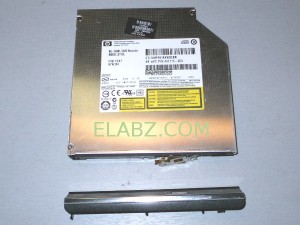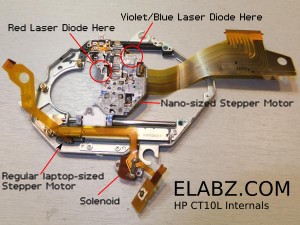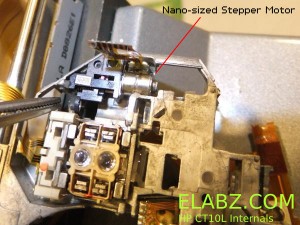Blu-Ray Teardown – HP CT10L BD-ROM / DVD Rewriter
This time the broken drive teardown is performed on an HP CT10L BD-ROM/DVD Rewriter drive (HP part number HP nPC P/N:491775-6CO). This is an older drive (manufactured in October 2008) and I expected it to have some useful parts – my experience has been that the most useful for disassembly parts are usually from 2003-2008 time frame. I was surprised to find not only two useful laser diodes inside but also an interesting part I did not expect to be in there …
Inside the HP CT10L BD-ROM drive is pretty much your usual set of usable mechanical parts: a laser diode sled on two parallel slides. The sled is driven by a laptop-sized bipolar stepper motor. Unfortunately, I promptly damaged the motor by a clumsy attempt to solder leads directly to the tiny wires of the winding. Note to self and others: if you’re not planning to re-use the flat cable attached to the motor, it’s much better to cut the cable off but leave the part that’s soldered to the motor leads. It will serve as an additional holder for the winding wires. Otherwise they are only held by what seems a polyethylene (or another low melting temperature plastic) clip which promptly melts and lets the wires get lost inside the motor.{adinserter Internal_left}This sled stepper motor deserves special attention from the DIY laser cutter stand point because it’s coupled to a lead screw with lead step of only 1.85mm (sled moves 1.85mm when the motor’s shaft rotates once) – which is an improvement compared to the 3mm lead step of desktop Bluray/DVD/CD drives. If (need more investigation on that) the laptop stepper is wound to also provide 20 steps per revolution, it will result in smaller steps and therefore better positional accuracy.
Despite the loss of this motor, I have a great amount of others just like that. I’ve disassembled 20+ drives so far 🙂 and most of my disassembled Bluray/DVD/CD drives are laptop variety because they are the cheapest and the most available in the “Broken, for parts” condition. So, I’ll be looking into the number of steps per revolution and maybe even base my laser cutter on laptop parts because of that. I’ll post more about that later.
The unexpected part inside the drive is this tiny little bipolar stepper motor coupled to a tinier yet lead screw that’s so small that I can’t even reliably measure it’s step – it seems in 0.3-0.4mm range. It drives a bracket with a little lens and is positioned in the optical path of the 405nm laser – I did not realize that before opening this drive that apparently, Blu-ray drives need to change their reading laser focal length. I’ve got to read more on why would that be the case. Anyhow, I have not even attempted to drive this motor yet. It’s got two 10Ohm windings and I would need to devise a way to drive it with 1.8V. Not sure if driver ICs I got (like SN754410) can drive motors with voltages so much less than the logic supply +5V. Need to do some research on that. But is seems a fun and challenging project – to make this nano-sized bipolar stepper move. Maybe I can even use it for focusing the laser in my laser cutter? We’ll see.Here is another look at the tiny little stepper. What’s amazing is that, looking at the flat cable and inside the black plastic linear slide, there appears to be an even tiny little zeroing switch in there! This little assembly is a wonder of miniature engineering. I should definitely look into making some use of it in one of my projects later. If I can manage to solder to it somehow without loosing it on the bench…
As far as the real reason I opened the drive in the first place – the laser diodes it contained – I was also pleasantly surprised to find two working laser diodes inside.
One of them is a more common 650nm (red) high-power laser diode used by the drive in recording onto the DVD media. The HP CT10L BD-ROM/ DVD Rewriter is spec’ed as a 4X BD-ROM reading, 5X DVD-RAM Writing, 8X DVD-R Writing. So, based on the writing speed vs. laser diode power output table, I would estimate it to be a 140mW optical output diode. It is a bit less than you’d want for cutting most materials but it could just work fine for cutting black craft foam.
The other laser diode is the 405nm (violet-blue) laser diode which I think has optical output in the 80mW range. I did not have a laser diode driver that outputs enough current to drive it at the max power range. This diode needs 110mA to 140mA drive based on the operating voltage of 5.4V (data from Sanyo BLUE-VIOLET LASER DIODE DL-7146-101S datasheet) Please note that there’s one important difference between this diode and the datasheet – the can is 3.8mm in diameter, so it’s size is more like this Opnext HL45023TG Laser Diode except, of course, it’s a 405nm and not 445nm.
Except for the tiny TO-38 (3.8mm diameter) can that I cannot find any housing for, both diodes seem to be pretty useful, at the very least if not for laser cutting then for high-powered laser pointer projects. Regarding the 3.8mm housing though, I’ve started a forum thread about it: Can anyone recommend a TO-38 (3.8mm) laser diode housing? . If you are also looking for this size housing, check this thread, there may be posts and comments by me or other site visitors – hopefully someone can send us in the right direction 🙂 !
So, to recap: the little drive yielded quite an array of usable parts:
- 405nm (violet-blue) 80mW laser diode
- 650nm (red) 140mW laser diode
- Laptop-sized bipolar stepper motor with 1.5″ long 1.85mm step lead screw.
- Three-phase spindle BLDC motor (see my BLDC with Arduino post about driving this motor)
- A nano-sized bipolar stepper motor – 4mm dia x 5mm long body, 4mm long lead screw with approx 0.3mm step
- A small solenoid
- Whole bunch of ICs much of which will most likely be of no use, except maybe for trying to desolder SMD components?
All in all, the HP CT10L was a good find from the DIY parts hunt stand point!





[…] little wonder of electromechanical engineering came from inside a laser diode sled of an HP CT10L Bluray drive I’ve opened some time ago. The device on the picture consists of several parts, all easily fitting on a dime […]
Would you happen to know where the driver is for the CT10L drive is? Haven’t been able to locate it. Hard to watch blue-ray and burn dvd-roms. Leawo works for watching blue-ray.